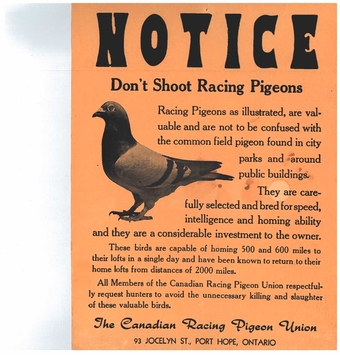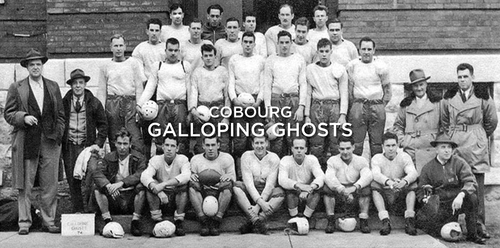Pigeon Racing-Cobourg Area History

Pigeon racing is the sport of releasing specially trained racing pigeons, which then return to their homes over a carefully measured distance. The time it takes the animal to cover the specified distance is measured and the bird’s rate of travel is calculated and compared with all of the other pigeons in the race to determine which animal returned at the highest speed.
It is thought that the sport of racing pigeons may go back at least as far as 220 AD or possibly earlier. Modern pigeon racing originated in Belgium in the mid 19th century. It is still a major sport in Belgium, where a bird, named after Usain Bolt, was sold to a Chinese businessman for $400,000.
The predecessors of modern-day racing pigeons were pigeons bred for their homing ability, primarily to carry messages. Pigeons were used for this purpose during the First and Second World Wars. During World War I and World War II, the U.S. military enlisted more than 200,000 pigeons to conduct surveillance and relay messages.
The sport of pigeon racing started in Cobourg in 1935. Founding members were John Fox and Ken Medhurst. Members of the Cobourg Racing Pigeon Club included G.H. Rollings, Ish Manton, Irwin Hie, John Hilliard, Ken Medhurst, Ernie Johns, Ron Clayton, Lyal Caine, Dan Parsons, Mike Markle John Fox and Lyle Landymore.
The club operates under the Charter of the Canadian Racing Pigeon Union. Each member has their own pigeon loft. John Fox and Ken Medhurst have been racing pigeons since the formation of the club. John Fox, of Cobourg, has been involved in the sport for 73 years, since he was 13 years old.
The Cobourg Racing Pigeon Club is part of a combine that includes clubs from Kingston to Bowmanville and is known as the Eastern Ontario Combine. G.H. Rollings, John Fox and Ken Medhurst, of Cobourg, were the top pigeon racers for many years.
Races used to run east and west with progressive distances for the pigeons. Today, races are north and south up to 600 miles. Flights today are from such places as Mattawa and points north to Hearst, Ontario. The fight home for a bird from Hearst, Ontario is approximately 990 km. The pigeons are transported to release points by tractor trailer that can carry as many as 80 pigeon baskets.
The Cobourg Sentinel Star of June 18th, 1959 reported the Cobourg Racing Pigeon Club’s race results from Gogama and Parry Sound. A race from Folleyette, a distance of 360 miles, on September29, 1962 was won Mike Markle of Cobourg. Mr. Markle took home $50.00 and a trophy. On September 2, 1964, the Cobourg Sentinel Star again reported that John Fox of the Cobourg club had won a Canadian Pigeon Union Trophy for capturing the combined 200 and 300 mile young bird average for 1964.
There are between 800 and 1000 members in the Canadian Racing Pigeon Club (www.crpu.ca) and Brad Foster of Cobourg is, at time of writing, the President. The Cobourg/Port Hope Racing Pigeon Club has 14 members and, at time of writing, the president is Shawn Whetstone.
****************
A Flying Fancy
By Layton Dodge
Cobourg Sentinel-Star May 10, 1967
Every Friday around supper hour, from May to September, several men gather in the barn of Erwin Hie on University Avenue East for a strange but intriguing ritual. What’s it all about? Well, this agent had occasion to find out first hand last weekend. They’re participating members in the ancient sport of pigeon racing, Cobourg chapter. At the invitation of Mike Markle, I went along to observe the standard procedure of pigeon fanciers in preparing for a race. It was a fascinating 90 minutes.
Thirteen fanciers were there and they had brought along in wicker crates the old birds they believed were ready for the week’s 150-mile flight from Ingersoll. Since there were more birds than the seven crates, which the Cobourg club has contracted to ship this year, could comfortably accommodate, deciding which 134 birds to send took a few minutes of deliberation.
Meanwhile, all the German-made clocks which are used to register the time in flight and the time of the pigeon’s arrival were synchronized. At exactly six o’clock, according to the WBEN radio time signal, each pigeon owner turned a key to start the clocks ticking.
Attaching a numbered rubber band to the leg of each pigeon was the next order of business. An aluminum band, bearing the serial number and year the bird was registered with the Canadian Pigeon Union for proof of ownership, breeding and records, already circled the other leg of every cock (male) and hen (female).
When the banding was completed, the loaded crates were transported by club member John Fox to Oshawa where a waiting truck carrying pigeons from other Eastern Ontario towns, took the birds to their takeoff destination. Early Saturday morning, the pigeons were released at Ingersoll, a club member was informed of the exact time of release and the race was on in earnest. A few hours later, anxious eyes of Cobourg fanciers were scanning the sky for the appearance of their birds. As I understand it, as soon as a bird lands, the rubber band is removed from the leg and inserted in the clock to record the official time of arrival on the slip in the clock. Within an hour or so, club members meet to open the clocks.
Because the starting point in any race is a fixed position (usually another town) but each bird’s loft varies in distance from the starting point, the method of determining a winner is unconventional and rather complicated. Consequently, the first bird “home” is not necessarily the winner. The race is determined on yards flown per minute. That’s where the mathematical mind of Ken Medhurst, who’s owned pigeons since he was 12 years old, comes in. Aided by a code book, he does all the intricate calculating.
Weather plays an important role in nearly all pigeon races. Losses can be staggering if birds encounter a bad summer storm. Times, of course, are adversely affected of those who do find their way home. A pigeon flyer always races his birds in the same direction, gradually increasing the distance as the bird matures. Young ones have the speed for short 200-mile races, but older birds, up to seven years, have the durability and experience for marathons.
Erwin Hie, one of the Cobourg club veterans, showed me through his coop, pointing out his oldest bird, nicknamed “Wa Wa”, which is 19 years of age. That’s roughly equivalent to a 100-year-old man. He also mentioned that if fanciers were smart, they would keep fewer birds in order to train them better.
Reviewed August 2020



2022 race results
can you send me the 2022 pigeon results old birds and young birds as they arrive please to my given e-mail as above